Found and heard all across America are the wonderfully loud woodpeckers who loves to hammer about in trees, usually the ones right near your bedroom window. Woodpeckers have a specialized bill that allows them to forage for insects within the bark of a tree. They and their distinctive behavior are known throughout the world, but for this particular guide, we will focus on woodpeckers residing in the state of Wisconsin. There are 8 species of woodpeckers in Wisconsin and they are:
- Hairy Woodpecker
- Red-bellied Woodpecker
- Downy Woodpecker
- Red-headed Woodpecker
- Black-backed Woodpecker
- Pileated Woodpecker
- Northern Flicker
- Yellow-bellied Sapsucker
Located in the north-central part of the U.S. is the state of Wisconsin. It is bordered by two of the Great Lakes: Lake Superior and Lake Michigan. Noted as the 23rd largest state, it has plenty of woodland areas and mixed forests that make great habitats for a variety of woodpecker species. The above 8 species of woodpeckers in Wisconsin can be found in the state year-round, except for one, and that is the Yellow-bellied Sapsucker. Below we will be going into further detail regarding each species size, coloration, and characteristics.
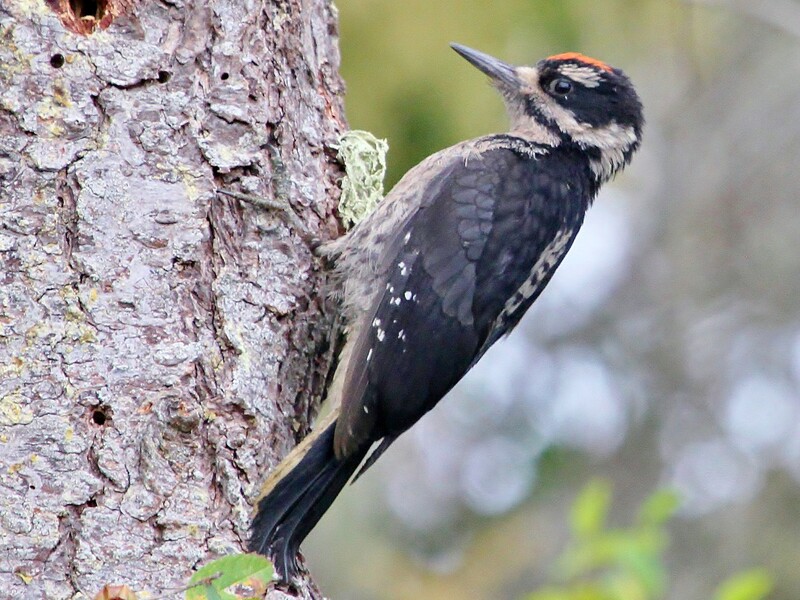
1. Hairy Woodpecker
Length: 7.1 – 10.1in
Weight: 1.4 – 3.4oz
Wingspan: 13.0 – 16.1in
Similar to Downy Woodpeckers, Hairy Woodpeckers are larger in both body and bill. Their plumage is patterned black and white, and they sit erect and on the lookout with their striped black and white heads that have a speck of red near the back. Although Hairy Woodpeckers in Wisconsin are found year-round, they do appear less than frequently than Downy Woodpeckers.
This species prefers tall trees in woodland areas and forests. They do not like to venture into open areas like parks and urban environments. Like most woodpeckers, they can be found near the main branches and at the trunk of the tree, pecking away for boring insects.
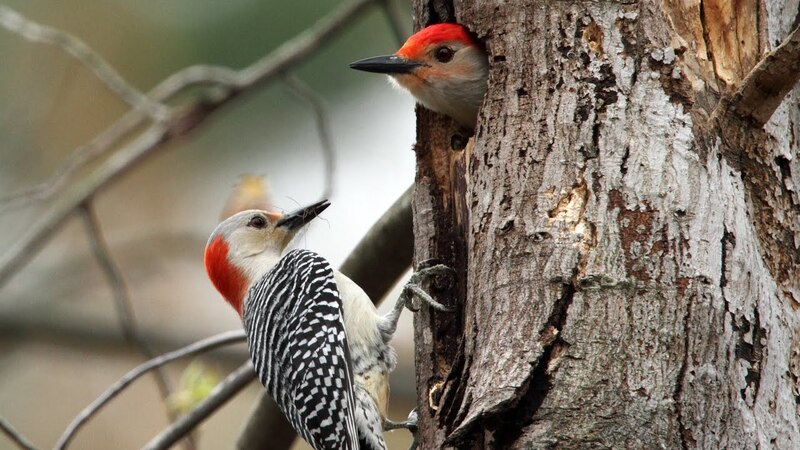
2. Red-bellied Woodpecker
Length: 9.4in
Weight: 2.0 – 3.2oz
Wingspan: 13.0 – 16.5in
Striking barred backs, pale plumage, and red caps make the Red-bellied Woodpecker easy to spot year-round throughout most of Wisconsin. Even though their name indicates a red belly, it is not often visible. They like to frequent eastern woodlands and sit about the middle of the trees, pecking and calling. Red-bellied Woodpeckers have a loud call and can be heard in the spring and summer.
These woodpeckers have several unique characteristics. They will take over the nest of other birds, store extra food in the cavities of trees, and they tend to fly erratically as a form of play and practicing flying maneuvers.
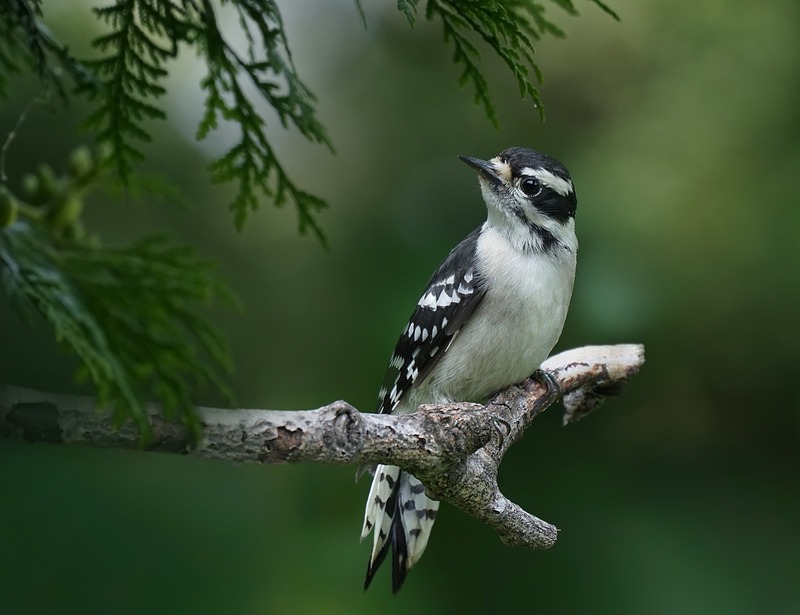
3. Downy Woodpecker
Length: 5.5 – 6.7in
Weight: 0.7 – 1.0oz
Wingspan: 9.8 – 11.8in
Downy Woodpeckers, as noted above, are similar in color to the Hairy Woodpecker but are the smaller of the two. They are found year-round in Wisconsin in woodland areas, parks, gardens, and backyards. This species, when compared to others, is the most likely to visit bird feeders with suet blocks and sunflower seeds. They have also been spotted flying about hummingbird feeders.
With their blocky heads and black and white plumage, the Downy Woodpecker, like all woodpeckers, will perch and drum out a tune on a tree rather than sing like other birds. They will also peck on metal to achieve the same effect. Most think all the noise they make is for finding food, but really they just want to tap out a tune and communicate.

4. Red-headed Woodpecker
Length: 7.5 – 9.0in
Weight: 2.0 – 3.2oz
Wingspan: 16.5in
Red-headed woodpeckers are easy to spot with their bright red heads and bold black and white wings. They are often noted as being flying checkerboards. Unfortunately, they have declined in numbers over the past 50 years. Red-headed woodpeckers like to nest and feed in open wooded lots, around dead timber in swamps, or savannas scattered with pine trees.
This particular species is similar to the Red-bellied woodpecker in the fact that they both like to store food. However, the Red-headed woodpecker goes a step farther and will cover the stored food with wood or bark. There are only four other species that do this.
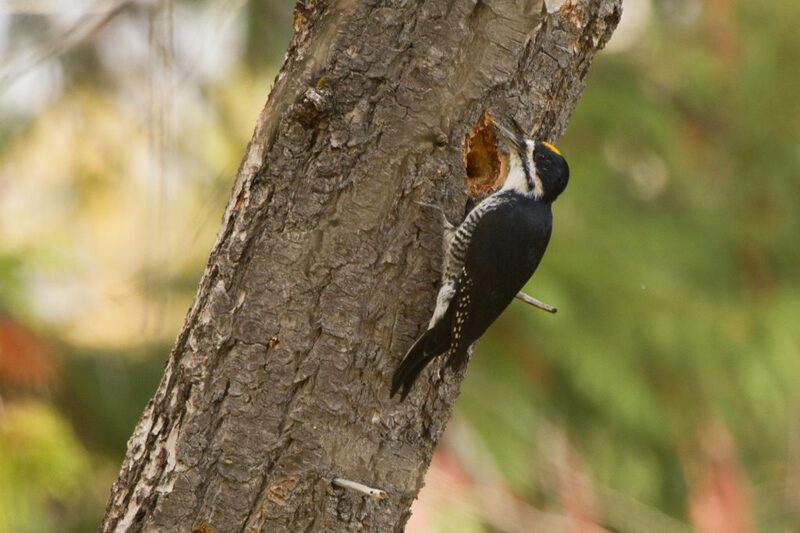
5. Black-backed Woodpecker
Length: 9.1in
Weight: 2.1 – 3.0oz
Wingspan: 15.5 – 16.5in
Black-backed Woodpeckers are named appropriately, seeing as how they are often found in burned forests. Their dark black plumage helps them fit right in among the scorched wood. Their underside and face are white and gray, and they are medium-sized, about the same size as the Hairy Woodpecker. Although they are found in the northern portions of Wisconsin throughout the year, the majority of Black-backed Woodpeckers range up through Canada.

6. Pileated Woodpecker
Length: 15.8 – 19.3in
Weight: 8.6 – 12.3oz
Wingspan: 26.0 – 29.5in
As the largest and easiest to identify, Pileated Woodpeckers are year-round residents of Wisconsin. Considered the largest species of woodpecker in North America, this species is almost the size of a common crow. They have bright white patches on the head and chest, along with a red, vibrant crest.
Something interesting about this woodpecker is the large, unique, oval-shaped holes they create in trees. They can be found foraging for carpenter ants in dead or fallen rotting trees. They will venture into yards for the occasional snack of suet.
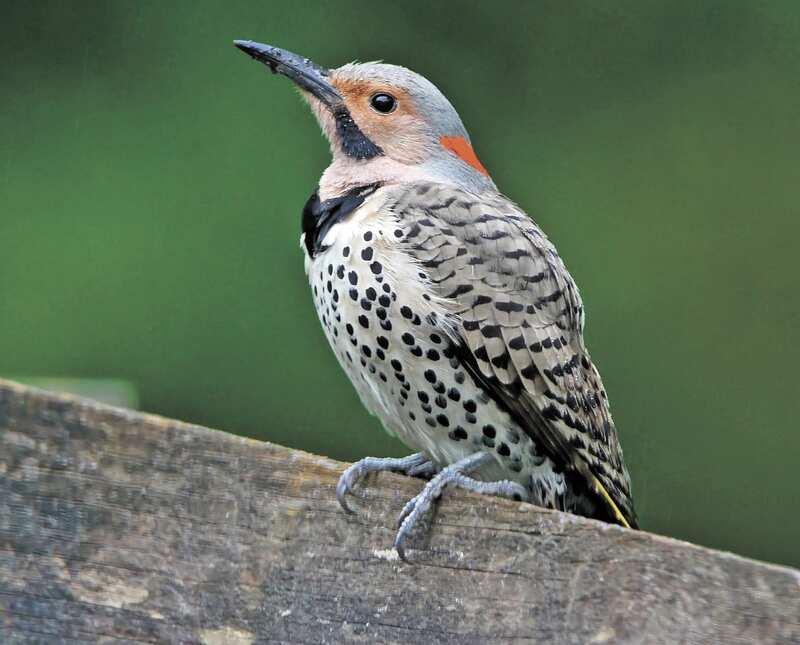
7. Northern Flicker
Length: 11.0 – 12.2in
Weight: 3.9 – 5.6oz
Wingspan: 16.5 – 20.1in
The coloring of the Northern Flicker is quite unique when compared to their counterparts. This species has a yellow-shafted and red-shafted version with dull, grayish-brown plumage with many tiny dark spots and markings on their underside.
These woodpeckers are often found in the ground rooting around for food year-round in Wisconsin. They like to venture through woodlands and on the edges of forests. The Northern Flicker’s curved bill helps them to dig in the earth rather than bore into trees.
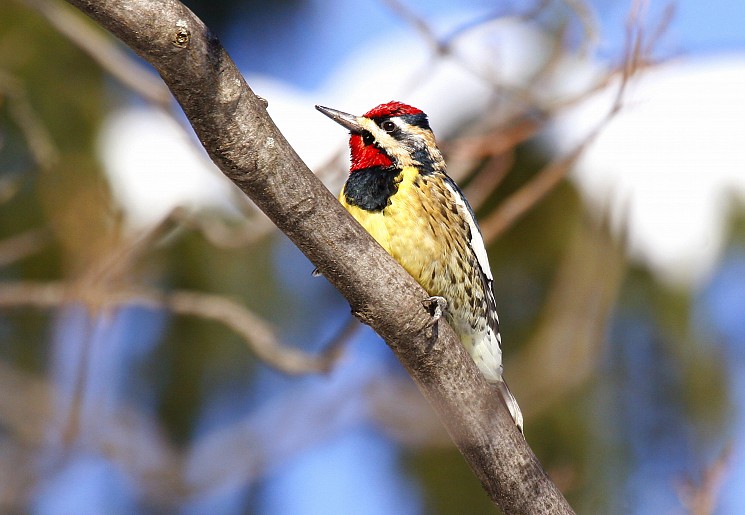
8. Yellow-bellied Sapsucker
Length: 7.1 – 8.7in
Weight: 1.5 – 1.9oz
Wingspan: 13.4 – 15.8in
As their name indicates, Yellow-bellied Sapsuckers are definitely sap-sucking woodpeckers. Found in deciduous forests, this woodpecker makes shallow holes while lapping up sap to trap insects. They leave behind neatly rowed sap wells when feeding.
When making holes, they create two: round or rectangular. As mentioned above, the shallow holes help to reach sap and trap insects, whereas the round holes are deep and used for probing for sap.
These birds are only found in Wisconsin during breeding season and sport a black and white plumage with red markings on their cap. They have yellow undersides, and males have red throat patches.
Woodpeckers: Is Attracting Them a Good Idea?
As we mentioned in the beginning, there is nothing like waking on a beautiful spring morning to the jackhammering of a woodpecker. Although the birds themselves are lovely to look at and fascinating to watch, it is actually best not to invite them into your yard. Woodpeckers can cause thousands of dollars of damage to a home. Below you can learn more about signs of woodpecker damage and how to deter them from setting up shop on your property.
If you hear a woodpecker nearby and want to determine their locale, look to the trees for the distinct holes they leave behind. Previously we mentioned that woodpeckers are actually quiet when foraging and eating. The hammering and pecking that we hear is actually their way of singing and communicating with other birds. Although many have unique calls, pounding away on a pine tree is their way of belting out a tune, talking, or courting.
Signs of Woodpecker Damage
Although this is fascinating behavior, it is also what makes them pests. Repeated drilling from a woodpecker can leave behind damage to a variety of surfaces, from wood to stucco. Characteristic woodpecker damage will resemble rows or columns of small to medium-sized, deep or shallow holes. You may even see larger nesting holes. You can always tell that it’s a woodpecker rather than insects because you will always hear them making their holes. Unlike other birds, woodpeckers will search for food or shelter near metal chimneys or gutters so as to tap loudly to claim and protect their territory.
It is imperative that you do not injure or kill it when trying to get a woodpecker to leave. Woodpeckers, like all birds, are integral parts of the ecosystem. They are protected in the U.S. by the Migratory Bird Act of 1918, even though they don’t migrate. To learn how to deter them from your yard, continue reading below.
Three Ways to Get Rid of Woodpeckers
Remove or Change the Food Source
Since insects are a woodpeckers’ primary food source, clearing out infestations will be important. Look for rotting or fallen trees; check for termite and beehives as well. You can treat your yard or have a professional come out and exterminate any unwanted infestations that would attract woodpeckers. If you have dead trees standing on your property, have them cut down to deter woodpeckers.
Even though you may do the above, woodpeckers may still frequent your yard. You can also try giving them something else to eat. Woodpeckers enjoy eating suet, a product made from cow fat. They tend to flock to this in late fall, winter, and early spring.
Set the feeder up near where the woodpeckers are located. As the days pass, gradually move the feeder farther and farther away from the original spot. Once summer approaches, remove the feeder completely. This will help the woodpeckers understand your location does not have a food source or trees to tap in.
Another food source that can be tried, if space permits, is growing fruit or berry trees. Woodpeckers enjoy fruits and berries, which will help them stay away from the home while providing them food and a place to be.
Frighten Them Away
Woodpeckers are like other birds when it comes to being frightened by objects that give off light or make a sound. Consider hanging objects in trees such as wind chimes, old CDs, pinwheels, or metal pie pans. Reflective tape can also be used in trees to scare woodpeckers away. By hanging long strips of the tape up in the trees, it will blow in the wind making noise and reflecting light. To note, the tape will need to be replaced every so often, depending on the weather in your area.
Decoy owls are another deterrent that can be placed in a tree to keep woodpeckers away. Owls are predators of woodpeckers, and they will feel threatened. However, it is important to move the owl regularly. Woodpeckers are smart, and leaving an owl in one place for too long will prove that it is of no harm to them. Sometimes even after moving the owl from tree to tree, homeowners have reported that it can become ineffective.
Prevent Woodpeckers from Returning
Bird netting is a more permanent solution to keeping woodpeckers away as well as returning. The mesh netting is hung about 3 to 4 inches from the surface, which is being damaged. This netting will physically deter the woodpeckers from trying to hammer at the surface. This netting can also be used for protecting the surrounding trees. Unfortunately, this method is time-consuming and can be expensive, depending on the amount of netting that you need. However, like the owl, this method is one of the most unnoticeable.
We hope the above guide has provided more information on the 8 species of woodpeckers in Wisconsin, as well as the information on how to look for and prevent damage to your property and home.
Related
- Have you ever stopped and wondered: how long does it take for a bird egg to hatch? How does incubation actually work? We have too, and that’s why we did some research and put together a guide around the expected incubation periods for various birds.
- If you are looking to attract our little noisy friends to your yard (and your neighbors are cool with it), you can check out our picks for the 6 Best Woodpecker Feeders.
[Website Page]Online bird guide, bird ID help, life history, bird sounds from Cornell
https://www.britannica.com/animal/woodpecker
[Website Page]
Leave a Reply